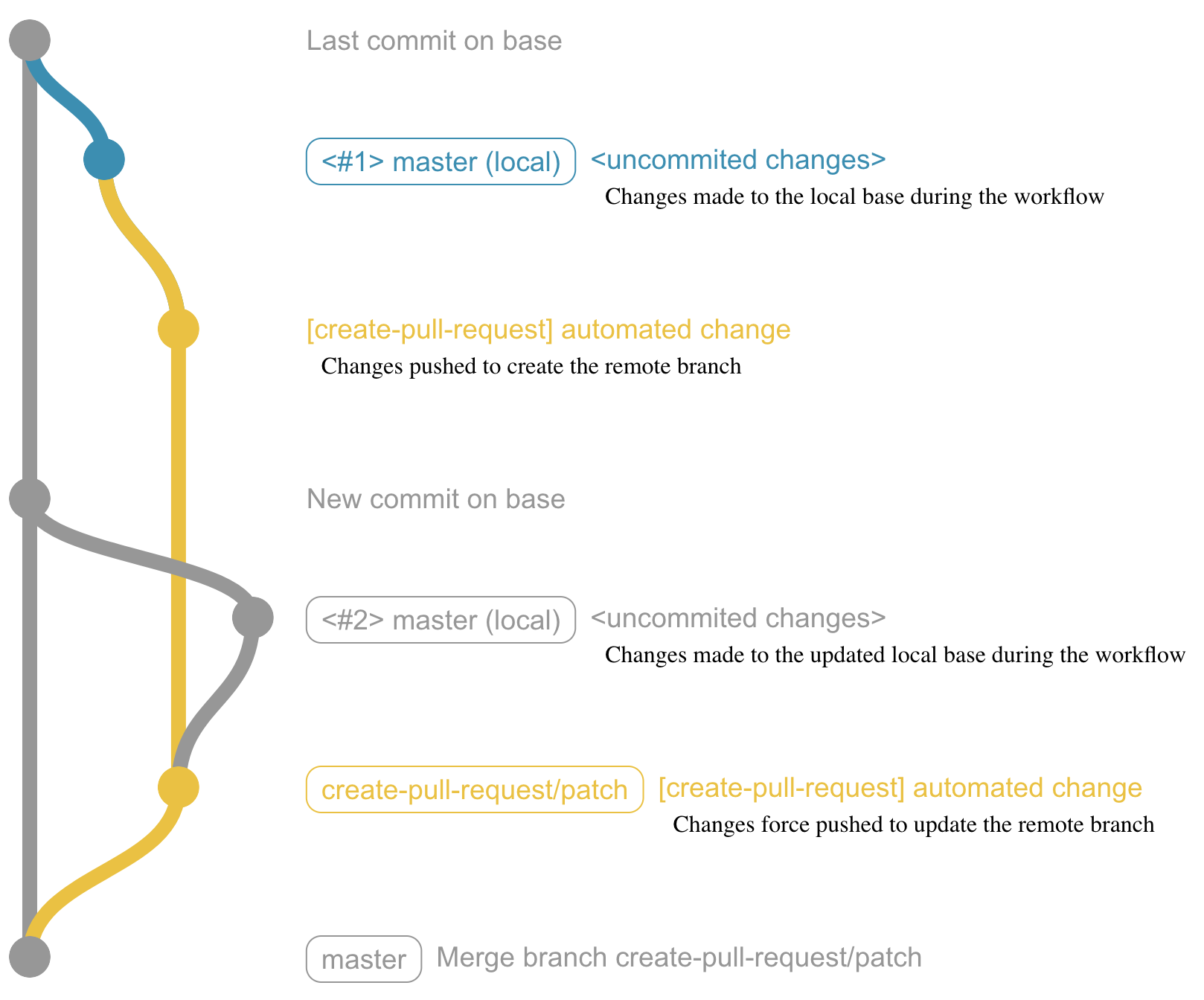# Concepts and guidelines
This document covers terminology, how the action works, and general usage guidelines.
- [Terminology](#terminology)
- [Events and checkout](#events-and-checkout)
- [How the action works](#how-the-action-works)
- [Guidelines](#guidelines)
- [Providing a consistent base](#providing-a-consistent-base)
- [Pull request events](#pull-request-events)
- [Restrictions on forked repositories](#restrictions-on-forked-repositories)
## Terminology
[Pull requests](https://help.github.com/en/github/collaborating-with-issues-and-pull-requests/about-pull-requests#about-pull-requests) are proposed changes to a repository branch that can be reviewed by a repository's collaborators before being accepted or rejected.
A pull request references two branches:
- The `base` of a pull request is the branch you intend to change once the proposed changes are merged.
- The `branch` of a pull request represents what you intend the `base` to look like when merged. It is the `base` branch *plus* changes that have been made to it.
## Events and checkout
For each [event type](https://help.github.com/en/actions/automating-your-workflow-with-github-actions/events-that-trigger-workflows) there is a default `GITHUB_SHA` that will be checked out by the GitHub Actions [checkout](https://github.com/actions/checkout) action.
The majority of events will default to checking out the "last commit on default branch," which in most cases will be the latest commit on `master`.
The default can be overridden by specifying a `ref` on checkout.
```yml
- uses: actions/checkout@v2
with:
ref: master
```
## How the action works
By default, the action expects to be executed on the pull request `base`—the branch you intend to modify with the proposed changes.
Workflow steps:
1. Checkout the `base` branch
2. Make changes
3. Execute `create-pull-request` action
The following git diagram shows how the action creates and updates a pull request branch.

## Guidelines
### Providing a consistent base
For the action to work correctly it should be executed in a workflow that checks out a *consistent base* branch. This will be the base of the pull request unless overridden with the `base` input.
This means your workflow should be consistently checking out the branch that you intend to modify once the PR is merged.
In the following example, the [`push`](https://help.github.com/en/actions/automating-your-workflow-with-github-actions/events-that-trigger-workflows#push-event-push) and [`create`](https://help.github.com/en/actions/automating-your-workflow-with-github-actions/events-that-trigger-workflows#create-event-create) events both trigger the same workflow. This will cause the checkout action to checkout commits from inconsistent branches. Do *not* do this. It will cause multiple pull requests to be created for each additional `base` the action is executed against.
```yml
on:
push:
create:
jobs:
example:
runs-on: ubuntu-latest
steps:
- uses: actions/checkout@v2
```
Although rare, there may be use cases where it makes sense to execute the workflow on a branch that is not the base of the pull request. In these cases, the base branch can be specified with the `base` action input. The action will attempt to rebase changes made during the workflow on to the actual base.
### Pull request events
Workflows triggered by `pull_request` events will by default check out a [merge commit](https://help.github.com/en/actions/automating-your-workflow-with-github-actions/events-that-trigger-workflows#pull-request-event-pull_request). To prevent the merge commit being included in created pull requests it is necessary to checkout the `head_ref`.
```yml
- uses: actions/checkout@v2
with:
ref: ${{ github.head_ref }}
```
### Restrictions on forked repositories
GitHub Actions have imposed restrictions on events triggered by a forked repository. For example, the `pull_request` event triggered by a fork opening a pull request in the upstream repository.
- Events from forks cannot access secrets, except for for the default `GITHUB_TOKEN`.
> With the exception of GITHUB_TOKEN, secrets are not passed to the runner when a workflow is triggered from a forked repository.
[GitHub Actions: Using encrypted secrets in a workflow](https://help.github.com/en/actions/automating-your-workflow-with-github-actions/creating-and-using-encrypted-secrets#using-encrypted-secrets-in-a-workflow)
- The `GITHUB_TOKEN` has read-only access when an event is triggered by a forked repository.
[GitHub Actions: Permissions for the GITHUB_TOKEN](https://help.github.com/en/actions/automating-your-workflow-with-github-actions/authenticating-with-the-github_token#permissions-for-the-github_token)
These restrictions mean that during a `pull_request` event triggered by a forked repository the action will be unable to commit changes to a branch.
A job condition can be added to prevent workflows from executing when triggered by a repository fork.
```yml
on: pull_request
jobs:
example:
runs-on: ubuntu-latest
# Check if the event is not triggered by a fork
if: github.event.pull_request.head.repo.full_name == github.repository
```